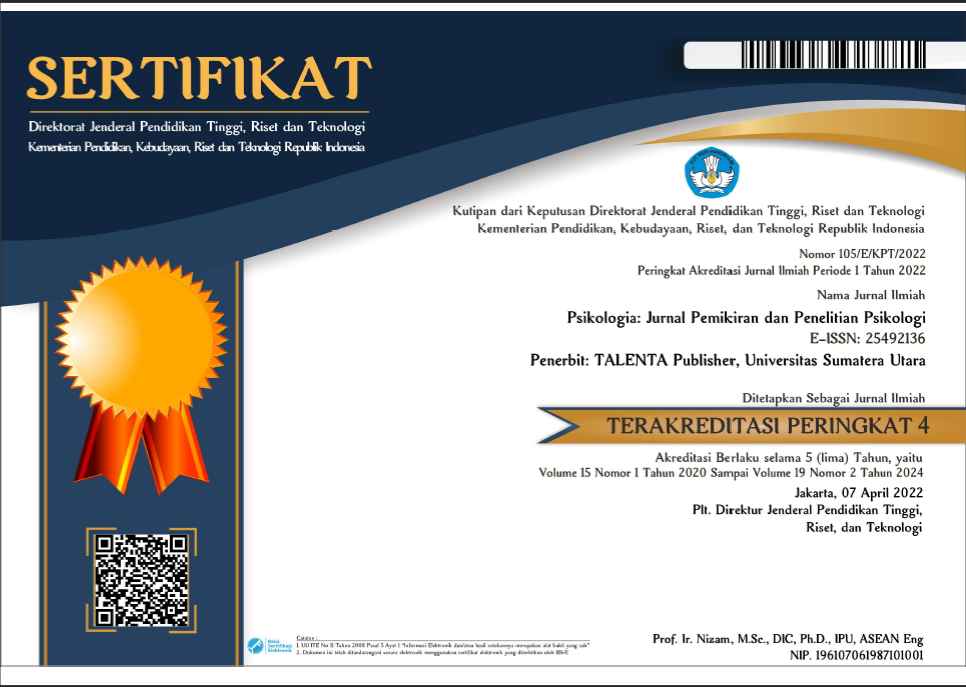The roles of driver stress on driving style
Peran stres berkendara terhadap gaya berkendara
DOI:
https://doi.org/10.32734/psikologia.v16i1.6813Keywords:
driver stress, dangerous driving style, safety-priority driving style, stres berkendaraAbstract
The present study examines the relationships between driver stress and driving style. The results of the present cross-sectional study (N = 819) revealed that increased levels of driver stress were associated with an increased tendency to engage in dangerous driving style and decreased tendency to engage in safety-priority driving style.
Penelitian ini menguji hubungan antara stres pengemudi dan gaya mengemudi. Hasil studi cross-sectional saat ini (N = 816) mengungkapkan bahwa peningkatan tingkat stres pengemudi dikaitkan dengan peningkatan kecenderungan untuk melakukan gaya mengemudi yang berbahaya dan menurunkan kecenderungan untuk melakukan gaya mengemudi yang memprioritaskan keselamatan.
Downloads
References
Dorn, L., Stephen, L., Wåhlberg, A., & Gandolfi, J. (2010). Development and validation of a self-report measure of bus driver behaviour. Ergonomics, 53, 1420–1433. https://doi.org/10.1080/00140139.2010.532882.
Hill, J. D., & Boyle, L. N. (2007). Driver stress as influenced by driving maneuvers and roadway conditions. Transportation Research Part F: Traffic Psychology and Behaviour, 10(3), 177–186. https://doi.org/10.1016/j.trf.2006.09.002.
Hu, L., Bao, X., Wu, H., & Wu, W. (2020). A study on correlation of traffic accident tendency with driver characters using in-depth traffic accident data. Journal of Advanced Transportation, 2020. https://doi.org/10.1155/2020/9084245.
Komite Nasional Keselamatan Transportasi. (2016). Data investigasi kecelakaan.1–20. https://knkt.dephub.go.id/knkt/ntsc_home/Media_Release/
Matthews, Gerald. (2002). Towards a transactional ergonomics for driver stress and fatigue.Theoretical Issues in Ergonomics Science,3. https://doi.org/10.1080/14639220210124120.
Matthews, G, Emo, A. K., & Funke, G. J. (2012). The transactional model of driver stress and fatigue and its implications for driver training. Foreign Affairs, 91, 1689–1699. https://doi.org/https://doi.org/10.1017/CBO9781107415324.004.
Mohan, D., Tiwari, G., Khayesi, M., & Nafukho, F. M. (2006). Road traffic injury prevention training manual. Who, 1–126.
Rowden, Peter and Watson, Barry and Biggs, Herbert (2006) The Transfer of Stress from Daily Hassles to the Driving Environment in a Fleet Sample. In Proceedings Australasian Road Safety Research, Policing and Education Conference, Gold Coast, Queensland.
Sabbour, S. M., & Ibrahim, J. M. (2010). Driving behaviour, driver style and road traffic accidents among young medical group. Injury Prevention, 16(Supplement 1), A33–A33. https://doi.org/10.1136/ip.2010.029215.120.
Sagberg, F., Selpi, Bianchi Piccinini, G. F., & Engström, J. (2015). A review of research on driving styles and road safety. Human Factors, 57, 1248–1275. https://doi.org/10.1177/0018720815591313.
Scott, E. (2020). What is stress? In Verywellmind. https://www.verywellmind.com/stress-and- health-3145086.
Taubman-Ben-Ari, O., & Skvirsky, V. (2016). The multidimensional driving style inventory a decade later: Review of the literature and re-evaluation of the scale. Accident Analysis and Prevention, 93, 179–188. https://doi.org/10.1016/j.aap.2016.04.038.
Taylor, A. H., & Dorn, L. (2006). Stress, fatigue, health, and risk of road traffic accidents among professional drivers: The contribution of physical inactivity. Annual Review of Public Health, 27,371–391. https://doi.org/10.1146/annurev.publhealth.27.021405.102117.
World Health Organizations. (2019). The top 10 causes of death. In WHO. https://www.who.int/news-room/fact- sheets/detail/the-top-10-causes-of-death.
Published
How to Cite
Issue
Section
License
Copyright (c) 2021 Psikologia: Jurnal Pemikiran dan Penelitian Psikologi

This work is licensed under a Creative Commons Attribution-ShareAlike 4.0 International License.








